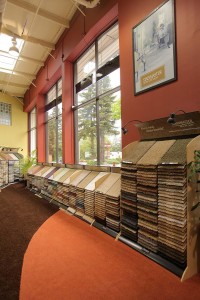When choosing a carpet, the average consumer tends to focus on the fibers while often neglecting to consider what’s beneath the surface. A carpet’s cushion (also known as the “backing” or “padding”) is an equally integral component, both prolonging the life of the carpet and providing additional benefits of insulation, noise reduction, and underfoot comfort. In the same way that many are unaware of the cushion’s vital role in a carpet’s performance, environmentally-conscious consumers tend to concentrate their scrutiny on the carpet’s face, even though such concerns apply just as much to the backing. Fortunately, there’s a wide variety of cushion options available for the discerning consumer.

Many carpet showrooms carry environmentally-friendly carpet cushion products. Photo: City Carpets (2013)
Regarding rebond
One of the most popular and commonly used styles of carpet cushion is bonded urethane, also known as “rebond.” Bonded urethane is composed of reclaimed scraps of high-density urethane foam used in furniture and automotive manufacturing. In addition to being a recycled product, it represents a reliably durable and considerably affordable option, available in a variety of thicknesses and densities so as to fit almost any carpeting situation.
However, while rebond carpet padding is considered eco-friendly in terms of its composition, some consumers may have concerns regarding the chemicals used in its manufacturing process. For instance, many urethane products contain butylated hydroxyl toluene (BHT), a chemical compound typically added to reduce the risk of fire during manufacturing. While BHT has no known health effects, many consumers insist on a carpet backing that’s entirely free of any such volatile organic compounds (VOCs). Only a few types of urethane foam meet this prerequisite, so conscientious consumers should be cautious when purchasing this type of carpet backing. In most cases, written assurances and/or certifications can be obtained from manufacturers and retailers confirming their products’ fulfillment of professed environmental standards.
For the purists: Fiber cushion
Another option for the especially eco-conscious is fiber cushion. These cushions are typically constructed from recycled scrap fiber, but they’re also available in varieties ranging from animal hair to bio-based materials like jute. While these options represent the optimum in sustainable, VOC-free manufacturing, the performance of this type of carpet padding tends to be questionable. In addition, fiber cushion is more expensive than more commonly used options like rebond.
New horizons
Industry innovation for carpet cushions is at an all-time high, as businesses continue to develop new and better ways to manufacture carpets that are sustainable, safe, durable and affordable. One recent product on the market is a carpet cushion made from postconsumer glass and polyvinyl butyral (PVB) plastic recovered from windshield and safety glass recycling. Another cushion that’s currently in development utilizes four to six percent polyol derived from soybean oil—a resource that’s not only renewable but, according to initial data, constitutes comparatively greater energy savings over the product life cycle than the standard petrochemical-based polyols.
To find a Diamond Certified carpet showroom in your area, click on one of the links below.
Contra Costa County: www.diamondcertified.info/contra-costa-carpet-showrooms
Marin County: www.diamondcertified.info/marin-carpet-showrooms
San Francisco: www.diamondcertified.info/san-francisco-carpet-showrooms
San Mateo County: www.diamondcertified.info/san-mateo-carpet-showrooms
Solano County: www.diamondcertified.info/solano-carpet-showrooms
